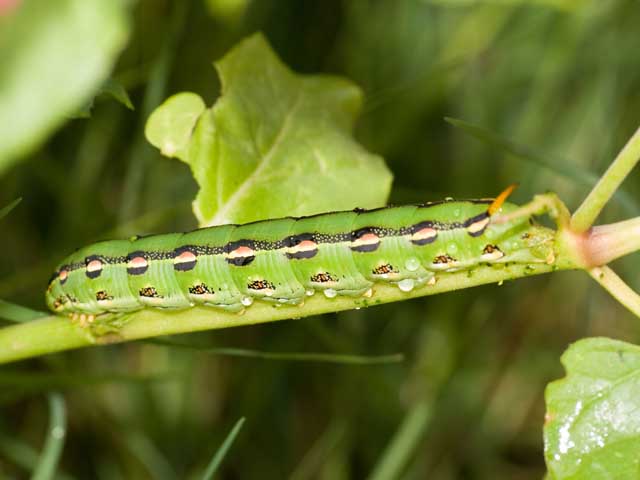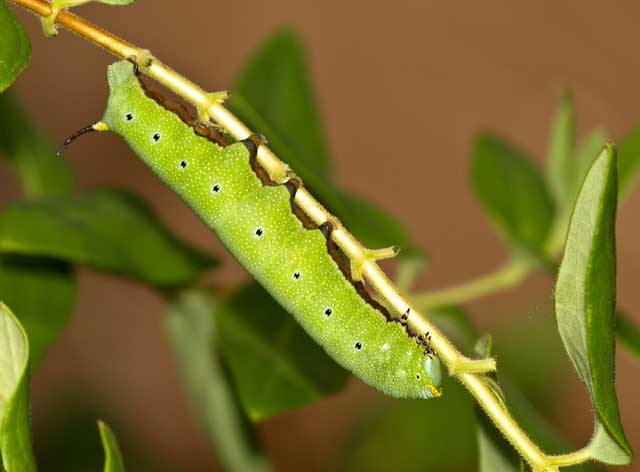
Hyles lineata fifth instar, Borger, Hutchinson County, Texas, courtesy of Wallace B. Thompson.
|
|
Updated as per James P. Tuttle's The Hawk Moths of North America, October 2009 Updated as per personal communication with Wallace B. Thompson, October 2009 - July 2010 |

Hyles lineata fifth instar, Borger, Hutchinson County, Texas, courtesy of Wallace B. Thompson.
This page is inspired by and dedicated to
Wallace B. Thompson who sent me the picture of
Hyles lineata larvae from Borger (Hutchinson County) at the top
of this page. Wallace also forwarded images of larvae of
Hemaris diffinis (next) and what I believe is a heavily parasitized
Paratrea plebeja (bottom of page). His picture of an adult Hyles lineata moth is posted on the
thumbnail page for
northern Texas.
Referring to the larvae, Wallace writes, "(Hyles lineata) Notice exudate along sides where I touched it.
A repellent I would guess;
(Hemaris diffinis) Found on honeysuckle vine;
(Paratrea plebeja) At first I thought it was the same as #2, but now I think a third variation that
has been parasitized by Braconid wasp. Found on same honeysuckle vine (more likely trumpet creeper,
Campsis radicans, amongst the honeysuckle)."
In July, 2010, Wallace and GayAnn Thompson sent me beautiful images of Eumorpha achemon, available via the link
below the E. achemon thumbnail.

Hemaris diffinis fifth instar, Borger, Hutchinson County, Texas, courtesy of Wallace B. Thompson.
The night-blooming moon flower will attract many Sphingidae at dusk and into the night.
For care of "found larvae/caterpillars" visit Manduca sexta larva, Travis County, central Texas, August 21, 2008, Trina Woodall.
Seventy-five Sphingidae species are listed for Texas on the U.S.G.S. website. Not all of the species are reported or anticipated in the northern region. It is hoped that this checklist, with the thumbnails and notes, will help you quickly identify the moths you are likely to encounter within the area bounded from Lipscomb south to Childress, west to Parmer, and north to Dallam County, east back to Lipscomb.
Please help me develop this list with improved, documented accuracy by sending sightings (species, date, location), preferably with an electronic image, via email to Bill Oehlke.
Sphinginae subfamily
Smerinthini Tribe:
Macroglossinae subfamilyDilophonotini tribe:
Philampelini tribe:
Macroglossini tribe:
|

Paratrea plebeja fifth instar (heavily parasitized), Borger, Hutchinson County, Texas, courtesy of Wallace B. Thompson.
Enjoy some of nature's wonderments, giant silk moth cocoons. These cocoons are for sale winter and fall. Beautiful Saturniidae moths will emerge the following spring and summer. Read Actias luna rearing article. Additional online help available.
Eggs of many North American species are offered during the spring and summer. Occasionally summer Actias luna and summer Antheraea polyphemus cocoons are available. Shipping to US destinations is done from with in the US.
Use your browser "Back" button to return to the previous page.
This page is brought to you by Bill Oehlke and the WLSS. Pages are on space rented from Bizland. If you would like to become a "Patron of the Sphingidae Site", contact Bill.
Please send sightings/images to Bill. I will do my best to respond to requests for identification help.
 Show appreciation for this site by clicking on flashing butterfly to the left. The link will take you to a page with links to many insect sites. |